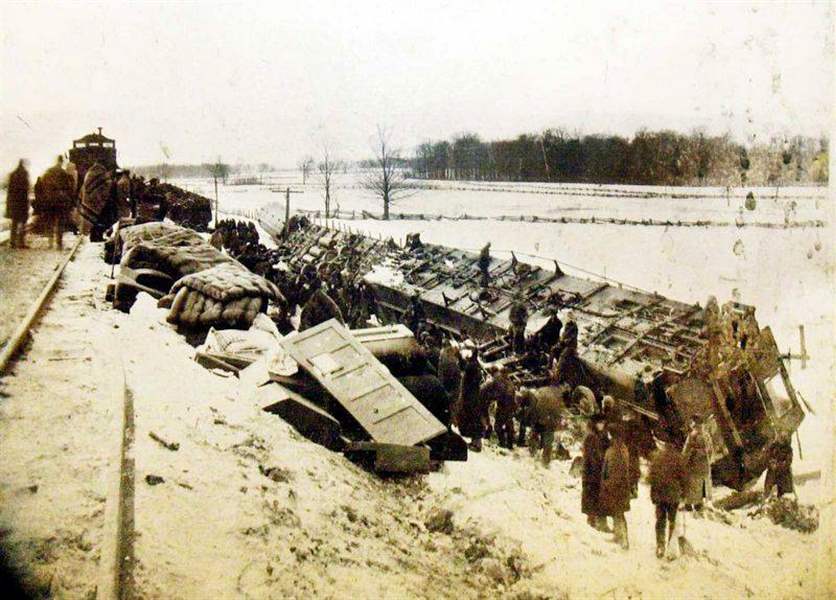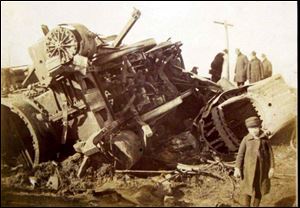
1901 wreck's horrific story is still potent
3/19/2007
Charred railcars, lie on their sides at the scene of the 1901 collision when the Wabash Railroad s westbound No. 13 collided with Wabash No. 4 passenger train 3 miles outside of Sand Creek. Nearly 100 northern Italian immigrants, who were on the westbound train headed for mining jobs, perished in the crash.

A youngster stands in front of the mangled debris.
TECUMSEH - The 1901 train crash continues to be remembered and retold in library presentations, books, songs, and on lazy Sunday afternoons, when grandmothers tell grandchildren about distant relatives now long departed.
Laurie Perkins, an educational historian at the Michigan Historical Museum in Lansing and author of the Wreck on the Wabash, yesterday described the night when westbound train No. 13 collided head on with an eastbound passenger train three miles outside of Sand Creek, Mich.
About 100 people - mostly northern Italian immigrants on the westbound train headed to mining jobs - died when the No. 13 and No. 4 trains burst into flames on the Wabash line.
"It's a story I learned as a young child," said Mrs. Dickens, a Sand Creek native. "And I had always thought it was pretty much a local story, but the history of this story is in the archives of newspapers across the country and abroad, and it's been remembered through those that pass it down generation to generation."
The Blade reported that immediately after the Thanksgiving Eve crash, six of the cars on the westbound train caught fire.
"The unfortunates fought madly in their attempt to crawl out of the doors and windows, thus hindering each other so that the bulk of them were unable to escape," according to the newspaper.

Charred railcars, lie on their sides at the scene of the 1901 collision when the Wabash Railroad s westbound No. 13 collided with Wabash No. 4 passenger train 3 miles outside of Sand Creek. Nearly 100 northern Italian immigrants, who were on the westbound train headed for mining jobs, perished in the crash.
A survivor described the scene in The Blade's Thanksgiving Day story.
"It was a veritable hell of fire," said Victor C. Greenbaum of New York City, who escaped with slight injuries. "People who came hurrying to the scene from farm houses in that locality, stood about the wreckage helplessly, and held their hands to their ears to shut out the frightful screams, and turned their eyes away because it was more than they could bear."
Mrs. Perkins yesterday recounted the horrific story, one she was first told when she began working at the Lenawee Historical Museum when she was 14 years old.
Of the 23 people attending the event at the Tecumseh District Library, most said the general narrative was familiar, but they said the lecture refreshed the details.
"When she started talking, it brought stuff up. It all just suddenly came back," said Charley Harpst, 67, whose uncles worked on the Wabash line.
Mr. Harpst said his uncles were not working at the time of the crash, but they heard about it through older workers and retold the tale to him.
"We're a Wabash family," he said.
Ruth Ann Deming, 69, said she first heard of the crash through a song.
The 1902 song, "The Wreck on the Wabash," written by Charles Decker helped memorialize the devastation that day:
"We could hear the cry of children 'neath the scattered coaches there, mingled with the roaring flames that leaped on high; While men and women vainly strove to reach the open air and fell back with one last despairing cry."
Aaron Strong, the engineer of train No. 4 who jumped to safety moments before the crash, was eventually blamed for the accident, but he was not held criminally liable for the deaths, Mrs. Perkins said.
Mr. Strong was quoted the day after the accident.
"I saw the headlight of No. 13, four or five miles before the collision occurred, but I supposed the train was sidetracked at Sand Creek, waiting for us to pass," he said. "The glare of the powerful electronic headlight made it impossible to see the exact location of the other train."
Mrs. Perkins said the No. 13 train - just upgraded to electric headlights from gas-powered headlights most trains used at the time - was going 60 mph when it hit the slower No. 4 train that was about half its size.
The trains, which were primarily constructed of wood, insulated with saw dust, and carrying coal-burning stoves, ignited in an explosion that could be seen and heard for miles, she said.
The immigrants, packed like cattle on board, had little chance of survival.
"The next morning, nearby resident came by the thousands, and when they started walking through the debris, they started kicking up white dust, and they knew where the travelers had gone," she said.